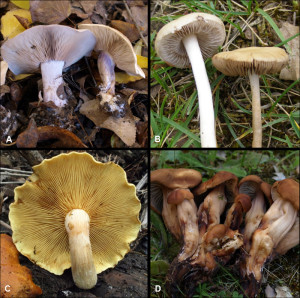
Representative lifestyles in Agaricales. Images A and B depict leaf litter degrading species growing in forest (Lepista nuda) and meadow (Agrocybe pediades) habitats, respectively. Image C is of a wood decaying species (Gymnopilus junonius). Image D is of a buried wood decaying species (Gymnopus fusipes). (Jose Maria Barrasa, Universidad de Alcala)
The analysis of sequenced genomes within the order Polyporales, which include most wood-rotting fungi, has improved our knowledge on the diversity of lignin-degrading oxidoreductases and carbohydrate-degrading hydrolases. However, comparatively few genomic studies have focused on lignocellulose-degrading Agaricales. This project focuses on the genomes of thirty-two representative saprobic Agaricales (thirteen wood decomposers, thirteen leaf litter decomposers, and six buried wood decomposers), for a large repertoire of enzymes acting on plant biomass, including cellulose, hemicelluloses, lignin and pectin degrading hydrolases and oxidoreductases, as well as other hydrolytic and oxidative enzymes.
Proposer’s Name: Jose Maria Barrasa, University of Alcala (Spain)